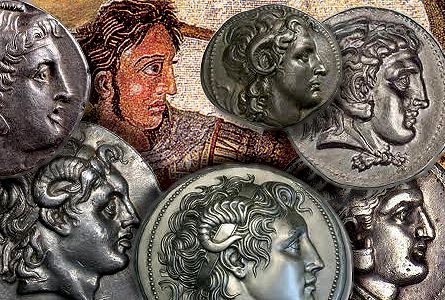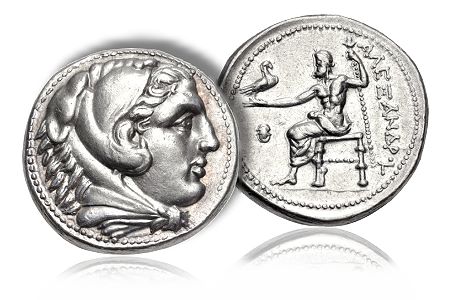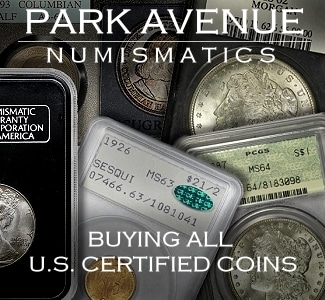Silver Tetradrachms of Alexander III of Macedon
NGC Ancients examines the silver tetradrachms of Alexander III of Macedon (356–323 BCE), better known as Alexander the Great.
Throughout history, few names resonate like that of Alexander the Great. Born a son of the Macedonian King Philip II in 356 BCE, this young man was tutored in war and philosophy by some of the most famed intellectuals of the day, including Aristotle. Upon the assassination of Philip II in 336 BCE, the 20-year-old Alexander was proclaimed king by Macedonian noblemen and the Macedonian army, and subsequently assumed command of his father’s forces.
What followed was a prolonged campaign of conquest that lasted until 323 BCE; a series of expeditions that has gone unmatched in documented military history of the West. During his lifetime, Alexander conquered lands as distant as modern-day Afghanistan, and, at the height of his power, controlled much of the Western world. His sudden death at the relatively young age of 32 in 323 BCE remains shrouded in mystery, and has been, at various times, attributed to a murder plot, lingering illness, or simply too much wine.
 Were he merely one of the conquering generals of antiquity, Alexander’s place in history would have been firmly secured. Even today, his exploits are the standard against which military men measure themselves. However, Alexander’s claims to fame are multitudinous; not only did he conquer vast territories and topple the Persian Empire, but he was also almost single-handedly responsible for the spread and lasting influence of Hellenistic culture. It was a culture that would take root and survive into the Roman era; it was perhaps Alexander’s greatest contribution to the world.
Were he merely one of the conquering generals of antiquity, Alexander’s place in history would have been firmly secured. Even today, his exploits are the standard against which military men measure themselves. However, Alexander’s claims to fame are multitudinous; not only did he conquer vast territories and topple the Persian Empire, but he was also almost single-handedly responsible for the spread and lasting influence of Hellenistic culture. It was a culture that would take root and survive into the Roman era; it was perhaps Alexander’s greatest contribution to the world.
For numismatists as well, Alexander is an extremely important figure in the history of ancient coinage. Although coins of Alexander were also struck in base metal and gold (and are highly collectible in their own right), his silver tetradrachms are among the most famous and instantly recognizable issues of the ancient world.
The tetradrachms of Alexander III are avidly collected today for both artistic beauty and historical significance. These coins, which were presumably first struck during the late 330s BCE, feature on the obverse Alexander in the guise of the demi-god Heracles (wearing a lion scalp), and on the reverse the seated figure of the supreme Greek god Zeus.
 Tetradrachms of Alexander are also noteworthy for the vast array of symbols and monograms that occur in the reverse field. These markings functioned much like modern-day mintmarks on United States coins; today they help numismatists decipher where a particular Alexander tetradrachm was minted.
Tetradrachms of Alexander are also noteworthy for the vast array of symbols and monograms that occur in the reverse field. These markings functioned much like modern-day mintmarks on United States coins; today they help numismatists decipher where a particular Alexander tetradrachm was minted.
More than 120 mints are known to have issued coinage of the Alexandrine type. Animals, religious objects, and representations of deities are among the symbols that the collector will encounter. This series of coins can be collected by symbol/monogram, and some of the scarcer issues command substantial premiums.
This coin is an excellent example of an early Alexander tetradrachm, which would have circulated throughout the empire. Note the amphora symbol that appears in the reverse field – this is just one of well more than a thousand symbol and monogram combinations that appear on coins of this series. Although the style, fabric, and other elements of these coins would change in very noticeable ways depending on both the mint and date, the Heracles-Zeus design would be struck well into the first century BCE, a remarkable lifespan for any coin type.
A more recent collecting trend focuses not on the artistic or topical interest of the symbols, but instead on what those markings reveal about when a particular coin was struck. Although some dating attributions remain highly conjectural and are subject to almost constant revision, a general picture of the dating of Alexander tetras has begun to emerge in the past few decades.
Assuming all other factors about an Alexander tetradrachm remain constant (i.e., condition, eye appeal, metal quality, etc.), most collectors of ancients will prefer a “lifetime issue” of Alexander to later issues, and they command a consistent premium within the series. This coin is an excellent example of a late (c.325-323 BCE) lifetime issue of the Macedonian king. This time, the symbol is the bucranium (an ox skull), which was an object of religious significance to the ancient Greeks. For purposes of comparison, a very similar symbol was employed on the Old Spanish Trail half-dollar commemorative of 1935.
Posthumous issues, considered types of Alexanders because they retain the same design elements as the original coins, were struck under his successors, the diadochi. Initially, the style and fabric of these coins remained more or less the same, as evidenced by this piece, struck in the name of Alexander’s half-brother and successor to the throne, Philip III (323-317 BCE). After 323 BCE, this coin type was used with the names of both Alexander III and Philip III.
In general, tetradrachms bearing Alexander’s name are posthumously attributed to Alexander down to about 275 BCE, after which things become more complicated. Over time, other kings and eventually powerful Greek city-states adopted the Heracles-Zeus type pioneered by Alexander III and made it their own. In general, by the second to first centuries BCE, flans had become dramatically wider and thinner, comparable in size to a modern-day silver dollar.
These coins, which are beautiful and represent an interesting field of study in their own right, are generally attributed to city-states believed to have issued them. This coin, which was struck in Mesambria c.250-175 BCE, illustrates some of the changes to the type by this time. The portrait is of a noticeably different style, and the flan is much wider and thinner than on lifetime and early posthumous issues of Alexander. Additionally, this tetradrachm from Mesambria, dating later still (to c.155-110 BCE), further demonstrates a change in style.
All images courtesy of Classical Numismatic Group





I did not see mention of the AR Tetradrachm, (17.09) obv Athena rv owl, olive spray, moon. C. 460-440bc, Attica, Athens. The one described here is rated XF☆